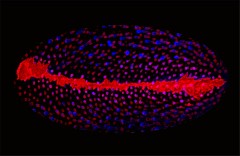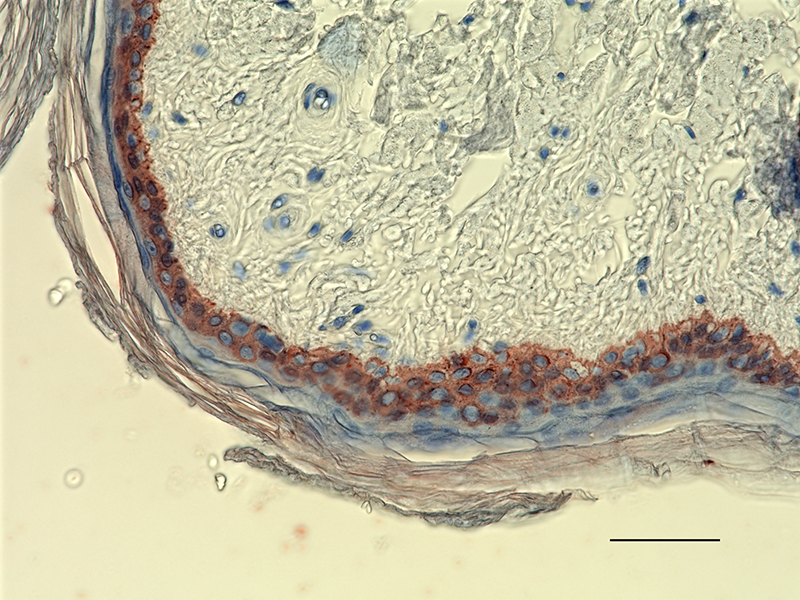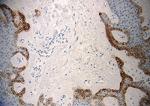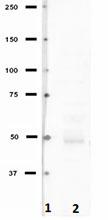- Clone
- Poly18339 (See other available formats)
- Regulatory Status
- RUO
- Other Names
- Keratin, type I cytoskeletal 15, CK-15, cytokeratin-15, keratin-15, beta, keratin-15, basic keratin-15, K15, cytokeratin 15, cytokeratin15
- Isotype
- Chicken IgY
- Ave. Rating
- Submit a Review
- Product Citations
- publications

-

Whole mount mouse tail epidermis was stained with purified anti-Keratin 14 (green, clone Poly19053), purified anti-Keratin 15 (orange, clone Poly18339) and DAPI (blue). Image generously submitted to the 2017 Cell Life Imaging Competition by Kif Liakath. -

IHC staining of anti-Keratin 15 antibody (Poly18339) on formalin-fixed paraffin-embedded human skin tissue. Following antigen retrieval using Sodium Citrate, the tissue was incubated with the primary antibody at 1 µg/ml for 60 minutes at room temperature. After incubation with biotinylated anti-chicken antibody, the tissue was labeled with BioLegend's HRP labeling reagent followed by addition of AEC Chromogen Concentrate. The tissue was then counterstained with hematoxylin, according to the protocol provided. -

Western blot of anti-Keratin 15 antibody (Poly18339). Lane 1: Molecular weight marker; Lane 2: Human skin lysate. The blot was incubated with the primary antibody at 5 µg/ml for 24 hours at 4°C, followed by incubation with an HRP goat anti-chicken IgY secondary antibody and chemiluminescence detection.
| Cat # | Size | Price | Quantity Check Availability | Save | ||
|---|---|---|---|---|---|---|
| 833904 | 100 µg | 286€ | ||||
Keratins are intermediate filament proteins responsible for the structural integrity of epithelial cells and are subdivided into cytokeratins and hair keratins. Keratin 15 is a member of the type I cytokeratin family. Most of the type I cytokeratins consist of acidic proteins which are arranged in pairs of heterotypic keratin chain. Keratin 15 has been associated with diseases such as malignant syringoma and morpheaform basal cell carcinoma.
Product DetailsProduct Details
- Verified Reactivity
- Human, Mouse
- Reported Reactivity
- Non-Human Primate
- Antibody Type
- Polyclonal
- Host Species
- Chicken
- Immunogen
- This antibody was raised against a peptide sequence derived from the C-terminus of the human keratin 15 protein, CDGQVVSSHKREI.
- Formulation
- Phosphate-buffered solution, pH 7.2, containing 0.09% sodium azide.
- Preparation
- The antibody was purified by affinity chromatography.
- Concentration
- 0.5 mg/ml
- Storage & Handling
- The antibody solution should be stored undiluted between 2°C and 8°C.
- Application
-
IHC-P - Quality tested
WB - Verified - Recommended Usage
-
Each lot of this antibody is quality control tested by formalin-fixed paraffin-embedded immunohistochemical staining. For immunohistochemistry, a concentration range of 1.0 - 10 μg/ml is suggested. For Western blotting, a concentration range of 1.0 - 10 μg/ml is suggested. It is recommended that the reagent be titrated for optimal performance for each application.
- Product Citations
-
- RRID
-
AB_2616894 (BioLegend Cat. No. 833904)
Antigen Details
- Structure
- Keratin 15 is a 456 amino acid protein with a molecular mass of 49 kD.
- Distribution
-
Tissue distribution: skin.
Cellular distribution: extracellular, nucleus, and cytoskeleton. - Function
- Keratin 15 is responsible for maintaining the structural integrity of mammalian epithelial cells.
- Biology Area
- Cell Biology, Cell Motility/Cytoskeleton/Structure, Neuroscience, Neuroscience Cell Markers
- Molecular Family
- Intermediate Filaments
- Antigen References
-
1. Liu Y, et al. 2003. J. Invest. Dermatol. 121(5)963. PubMed
2. Jih DM, et al. 1999. J. Cutan. Pathol. 26(3):113. PubMed
3. Leube RE, et al. 1988. J. Cell Biol. 106(4):1249. PubMed - Gene ID
- 3866 View all products for this Gene ID
- UniProt
- View information about Keratin 15 on UniProt.org
Related Pages & Pathways
Pages
Other Formats
View All Keratin 15 Reagents Request Custom Conjugation| Description | Clone | Applications |
|---|---|---|
| Purified anti-Keratin 15 | Poly18339 | IHC-P,WB |
Customers Also Purchased
Compare Data Across All Formats
This data display is provided for general comparisons between formats.
Your actual data may vary due to variations in samples, target cells, instruments and their settings, staining conditions, and other factors.
If you need assistance with selecting the best format contact our expert technical support team.
 Login / Register
Login / Register 














Follow Us